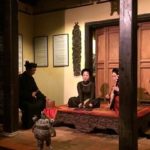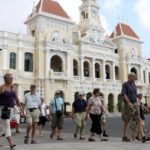Hoan Kiem District authorities, in coordination with Hanoi’s Department of Culture and Sports, are continuing their efforts to make the pedestrian zone around Hoan Kiem Lake more attractive, according to Nguyen Quoc Hoan, Deputy Chairman of Hoan Kiem District People’s Committee, who spoke to Hanoimoi Newspaper.
Could you share the achievements of the pedestrian zone around Hoan Kiem Lake and its surroundings on weekends, seven years after its launch?
| Local and foreign visitors enjoy many activities in the pedestrian zone around Hoan Kiem Lake. Photo: Pham Hung/The Hanoi Times |
In 2016, the Hoan Kiem District People’s Committee, with the approval of the city government, opened the weekend pedestrian zone around Hoan Kiem Lake and its surroundings to build a community-oriented space, improve the living environment, and highlight the values of local tangible and intangible cultural heritage to preserve, honor, and introduce Hanoi’s history, culture, and people.
The pedestrian zone around Hoan Kiem Lake and its surroundings has become a hallmark and a highlight of the capital city, providing a recreational space for the local community and domestic and foreign visitors.
During the day, an estimated 3,000-5,000 domestic and foreign tourists visit the pedestrian zone, and in the evening, the number increases to 15,000-20,000. Security and order are always ensured.
The pedestrianization of the area around Hoan Kiem Lake and its surroundings has encouraged walking, gradually reduced motorized traffic, and created a new way of life for Hanoi residents.
At the same time, it has effectively promoted the values of cultural heritage, the water landscape, and the greenery of Hoan Kiem Lake – a special national monument.
How does the district plan to preserve and enhance the value of Hoan Kiem Lake and its surrounding areas to attract more visitors?
Recently, efforts to conserve, restore, and promote the heritage values in Hanoi’s Old Quarter and Hoan Kiem Lake area have yielded positive results. The focus has been on conserving and restoring tangible heritage values.
The district’s People’s Committee has cleaned up the area, renovated and restored 22 historical sites, and preserved 24 heritage houses. The intangible heritage of the area has also been revived and promoted through the restoration of 14 festivals.
The district has also renovated and paved the sidewalks of all 79 streets with cobblestones, and has cleaned the underground sewers.
| Nguyen Quoc Hoan, Deputy Chairman of Hoan Kiem District People’s Committee. Photo: Hanoimoi Newspaper |
After restoration and revitalization, many historical sites and urban spaces in Hanoi’s Old Quarter have become cultural and artistic centers, showcasing traditional crafts associated with the trading streets and villages. They contribute to promoting the values of both tangible and intangible cultural heritage.
Notable examples include the Heritage House at 87 Ma May Street, the Kim Ngan Temple at 42 Hang Bac Street, the Hanoi Old Quarter Cultural Exchange Center at 50 Dao Duy Tu Street, the Quan De Temple at 28 Hang Buom Street, the Dong Lac Community House at 38 Hang Dao Street, the Nam Huong Community House at 75 Hang Trong Street, and the Arts and Culture Center at 22 Hang Buom Street.
In addition, Hoan Kiem District regularly hosts distinctive cultural and artistic programs and activities at historical sites. These include events showcasing the lifestyles of ancient Hanoians, traditional music performances, exhibitions, and introductions to traditional handicraft villages associated with the Old Quarter, revival of traditional festivals, and promotion of the Hang Trong folk painting genre to the public.
These programs always attract active participation from the community, contributing to the sustainable and long-term preservation of the cultural heritage of the Old Quarter.
What strategies do the local authorities propose to preserve the cultural beauty of the Old Quarter while building Hoan Kiem Lake’s pedestrian space as a fresh, modern, and unique tourist attraction?
The pedestrianization of Hoan Kiem Lake and its surroundings has revealed some limitations and challenges. The improper installation of stalls and inappropriate display of products have somewhat spoiled the pedestrian experience. Midnight running events have disturbed the daily routine of residents.
To address these issues, we, in cooperation with the Hanoi Department of Culture and Sports, have suggested to the Municipal People’s Committee to allow only cultural and artistic events that have distinctive characteristics and promote and showcase local culture.
The organization of these artistic activities in the pedestrian zone will also need careful consideration to avoid noise pollution. Events should be held away from residential areas to minimize the impact on residents’ daily lives.
The district has also launched a nighttime economic development project to leverage the potential and maximize the resources of the district, including the pedestrian areas in the Old Quarter and around Hoan Kiem Lake, Dong Xuan Night Market, and food streets such as Tong Duy Tan, Hang Buom, and Ta Hien. The goal is to make Hoan Kiem an alluring destination for night entertainment, shopping, culinary experiences, and other nighttime activities for tourists.
The district has also publicized a hotline system operated by the district People’s Committee, the district and district police, and the People’s Committees of all 18 wards to assist residents and tourists who are out at night in the area. They have installed a security surveillance camera system at key locations and major roads to ensure public order and safety. They also plan to expand the system throughout the district.
| Artisans from the village of Te Tieu perform a puppet show. Photo: Hoai Nam/ The Hanoi Times |
After being officially recognized as a city-level tourist area, what is the Hoan Kiem District authority’s plan to manage and develop the walking space sustainably and effectively?
According to Decision No. 5526 dated October 31, 2023, the Hanoi People’s Committee recognized the Hoan Kiem Lake area, including its vicinity and the Old Quarter of Hanoi, as a city-level tourism area.
In line with the decision, the district has instructed the Hoan Kiem Lake and Old Quarter Management Board to collaborate with relevant departments and agencies to propose solutions for sustainable tourism development.
The district has launched tours to visit the historical sites of Hoan Kiem Lake and the Old Quarter, including heritage and electric car tours around the ancient streets. They have also partnered with the Hanoi Tourism Department to organize the “Hanoi Night – The Touch of Emotions” program.
Furthermore, the district will work closely with the Hanoi Department of Culture and Sports and other departments and agencies to make the pedestrian area around Hoan Kiem Lake and the Hanoi Old Quarter even more inviting in the future.
These efforts aim to create a space for cultural exploration, architectural appreciation, culinary experiences, and entertainment for both residents and tourists.
Thank you!
Ancient house in Ma May
NDO – Ma May, a rare quarter that still retains several old houses, has created one of the characteristics of Hanoi. Hanoi’s streets are becoming increasingly crowded and traditional features can sometimes be hidden behind modern life. But if one takes the time to relax and look around, the ancient features begin to reveal themselves.
Hanoi, HCM City see good growth of tourism revenue
NDO – In the first ten months of 2016, the revenue of Ho Chi Minh City’s tourism industry amounted to VND80 trillion while Hanoi’s reached over VND50 trillion.











